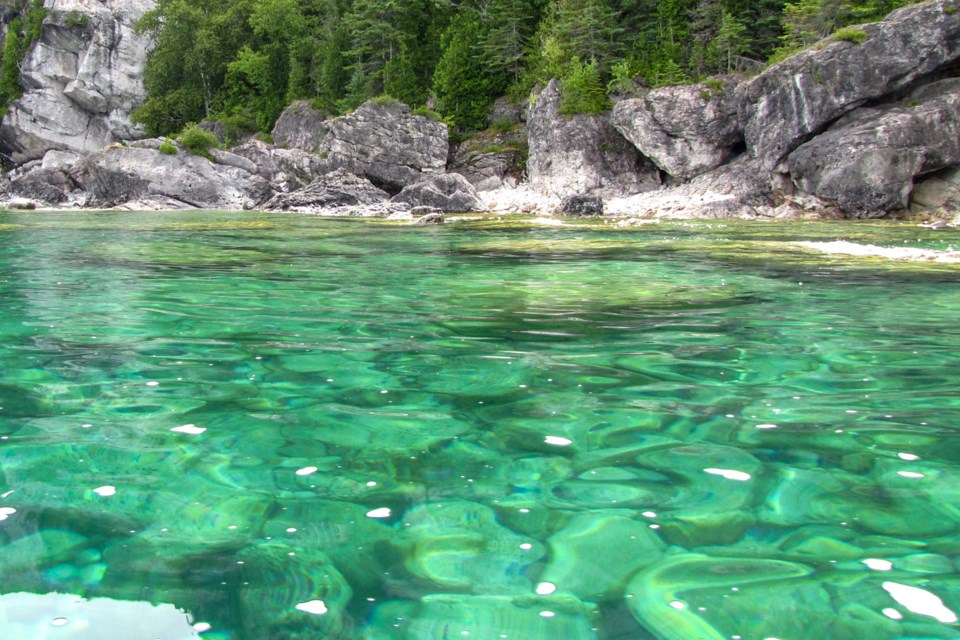The change in perspective catches you unaware. Sitting in your kayak, eye-to-eye with a great blue heron that is unafraid, you sense that you should ask its permission to share the warm, shallow bay you both occupy for sustenance, a sunfish or small bass to feed the bird, peace and calm to nourish you.
Rockway, Balls Falls or hiking the Bruce Trail north of Wiarton, we’ve all cautiously peered over the edge of the Niagara Escarpment somewhere to experience its beauty, height and majesty.
Yet one can’t begin to fully comprehend the Escarpment, a 450 million-year-old tropical seabed that’s now cracking limestone karst and fragmented sea stacks—a geological fortress that has battled ice ages—until you’ve bobbed below the cliffs of Lions Head or Cape Chin in a sea kayak, utterly alone, knowing there is no possible way to land and get out of the wind, or even rest for a moment, in the confused water at the cliff’s base.
The east coast of Georgian Bay and North Channel of Lake Huron, all windswept pink granite and stunted white pine with roots desperately clinging to rocks and thin layers of coarse sand, is a different world again. Paddling alone above shallow shoals too treacherous for powered boats to intrude, well beyond where anyone with a lick of common sense would ever build a cottage, fills one with exquisite calm.
An hour north of North Bay, where Ontario’s boreal forest reaches its farthest point south, is remote and hauntingly beautiful Wicksteed Lake. Its only access is one sandy double-track trail leading to a boat launch that locals will swear doesn’t exist if you ask for directions. As I prepared to paddle north into the lake alone, a contemptuous fisherman felt duty-bound to offer me this smidgeon of self-preservation advice: “It ain’t Muskoka, you know. Down there if you walk in a straight line, you’ll eventually cross a road. Up here, you won’t cross nothing.”
No wannabee Adam Shoalts here, just an obdurate soft adventure guy that couldn’t tell if it was a fat squirrel or a skinny bear that snapped the twig outside his tent at 2 a.m., and who would be too terrified to lift the tent fly to check. So why is kayaking top-of-mind now, in the first week of March?
Because with a decent drysuit or wetsuit and a bit of care, this crazy weather has gifted us rare ice-free Niagara paddling just 10 weeks into the year.
This crazy weather has gifted us rare ice-free Niagara paddling
More importantly, there are few better ways to experience that delicious mix of internal calm and positive apprehension than kayaking in people-free natural solitude. Dreaming and planning now will prepare us for the days ahead when many of us will want or need such an escape.
The benefits to our wellbeing of forest bathing and trees are becoming known. Reduced adrenaline, cortisol and dopamine production lowers stress and blood pressure. Less anxiety, anger, fatigue, and confusion improves immune system function and increases cancer-fighting white blood cells.
Yet Canadians now spend 90 percent of our day indoors, the highest percentage ever. A multitude of studies suggest being exposed to nature can boost vitality by up to 40 percent, while too much time spent indoors has the opposite effect.
Do water and paddling offer similar benefits to trees and forests?
Calm quickly descends when you reach the launch point and begin to unload your kayak from its car-top carriers. Your focus is concentrated lest you forget a vital piece of gear; spare paddle, bailing pump, paddle float, water bottles, hat, waterproof map for old-timers, and more.
Then apprehension and a slight smile appear as you realize this is all equipment designed to save your life should a mishap occur. This blissful mixture of relief and apprehension is exhilarating, immediately capable of clearing your mind and expanding your sensory perception. The water, with its inherent beauty and risk adds a variety to your nature experience that forests and solitary walks alone can’t manage.
How else, without noise or dependence on a motor, can you look right and see beautiful, weathered limestone cliffs or granite beaches, then glance left to see nothing but endless blue water shimmering in the sun as you float to the rhythm of the waves. Kayaking offers different angles and new perspectives with each paddle stroke.
We don’t just imagine these benefits—science suggests the impact of water on our body and psyche is real.
Water influences all our senses. We feel it warm or cool. We taste and smell it as pure, or a naturally mixed cocktail of whatever is floating and growing in it as we paddle. Water’s movement creates “pink noise,” similar to the steady background throb of white noise, but with a lower pitch and sound wave length that is more gentle and soothing.
Drinking water, or being near water, calms our nerves by activating our parasympathetic nervous system, which lowers our heart rate and blood pressure to aid in relaxing.
Even the colour of water influences our brains. The blue of Georgian Bay and our Great Lakes is known to be soothing, which helps us unwind and find our positive, creative energy. According to Feng Shui, the teabag-black colour of our inland lakes is associated with power, mystery and calm, all emotions that provide the mental balance our brains need to be fully alive.
The Peninsula Paddlers 2024 Open House is scheduled for April 2nd, 7:00 – 8:30 p.m., at Outdoors Oriented, 420 Vansickle Rd, St Catharines. Members will be available to answer questions and inspire. Check their website for details https://www.peninsulapaddlers.com/



